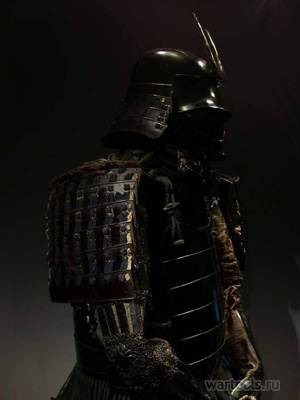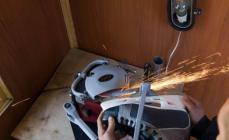Katana was used primarily as a cutting weapon, sometimes both stitching, allowing both two-handed and one-handed grip. The oldest school of ownership of the sword rolling takes their origin in the XV-XVI centuries.
The main idea of \u200b\u200bthe Japanese art of ownership of the sword (Kendwitu) and the technician-based technicians (such as Jewid) lies in the fact that the longitudinal axis of the sword during the attack should go to the target not at a right angle, but along its plane, causing cutting strikes. Therefore, it is more appropriate to speak not about blows - in the form in which they are characteristic of Western techniques of the sword - but about cuts. That is why the blades have a curved form.


The famous Japanese master Mike Miyamoto Musasi wrote the book "Gorin but Syo" ("Book of five rings"), in which he reveals his technique of two swords (Nitan-Ryu) and in Esoteric perspective explains it. Working with rod and Vakidzasi is similar to Escrima Takes (modern name - Arnis de Mano). Candyutsu, the practical art of fencing with a sword, was reborn in modern species - Ganda Budo. The art of a sudden attack and counterattack is called Jewid and is a meditative type of battle, which is conducted with an imaginary opponent. Cando - the art of fencing by a bamboo sword (Sinai), in which it is necessary to carry a set of protection similar to the fencing European and consisting of a helmet with a lattice closing face and armor. This type of fencing on swords, depending on the specific style (RU), can be practiced as a sports discipline.

In Japan, there are still numerous traditional fencing schools who managed to survive after the universal ban on Emperor Maidzi to wearing swords. The most famous are Casim Sinto Ryu, Casima Sin Ryu and Catori Sinto Ryu.
Katana in the media (media)
From the second half of the 20th century, the romance to the Middle Ages, the Far and Middle East and especially the Japanese culture began to gain frantic popularity. Contact with the Japanese culture in the West occurs mainly through anime, manga and Japanese cinema; Thus, the cinema samurai fights and duels of Heroes Anime are the main foundation for the ideas of Europeans about Japan, which are often perceived at all without any criticism. Nowadays, the trend of romanticization of Japanese blacksmith art is noticeable, which significantly reflected in the popular science documentation produced by National Geographic, Discovery Channel, History Channel, as well as in the Russian popular format "Military".
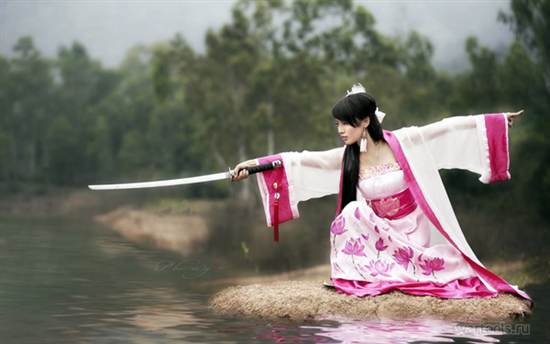
The most popular opinion that is supported by many popularizer specialists, which says, as if the Japanese sword is an absolute top of the forge art in the entire history of mankind. This opinion, nevertheless, does not withstand any archaeological, historical and metallographic criticism. Composite Japanese blades do not really represent anything "unusual" or "exceptional", as the archaeologists found Celtic blades of the V century BC. e. (that is, almost a thousand years older than Japanese), consisting of various purposefully cooked varieties of steel. Research of Roman Gladiusov and Roman-German welded revealed complex welded structures and selective hardening of many swords. For example, individual Roman gladiuses not only turned out to be selectively hardened, but also showed the hardness of the blade to 60 units on the Rockwell scale. In particular, the welded blades of the early Middle Ages are made at a very high level of skill. This is proved first of all the work of Stefan Meduse, who, in the framework of a special project, together with Japanese polishing plants of higher ranks polished European Rated Westerns (two Scratsaks and One Welded Spaw) in the Japanese method. The results clearly show that even the grimacs of the Germans consisted of excellent refined steel, folded and cited at no less than Japanese steel blades. Selective hardening were also discovered and at least two varieties of steel. This proves that composite blades from various varieties of steel, raffination methods and selective quenching have never been solely Japanese. Middle Eastern and Central Asian blacksmiths owned all these methods as far as their European and Japanese colleagues. Swords and knives of the same quality, as well as Japanese, were made in Europe since the time of the Roman Empire, that is, at a time when the development of the local technology of the cheese furnace began in Japan. From a historical and metallographic point of view, the superiority of the Japanese sword over all the other is unproved and is the product of the western popular culture of the 20th century.

Properties of material
It is often mentioned that as if because of the soft footage (core) and a very hard cutting edge, Japanese swords are almost not affected and cut with the same efficient solid steel and organic materials. In fact, this opinion was influenced by anime and romantic interpretation of Japanese legends. From the point of view of physics, heat-treated steel in 45-60 units of Rockwell can not be cut (and not just broken) exactly the same steel. Iron as a material is not comparable to steel, so the popular show where the rolled knobs cut into soft tin sheets in half a millionth, are not proof. Also there are also no historical sources, confirming the ability of any swords to "cut as oil" steel plates from 1 mm and above 30 units of Rockwell, so these opinions are considered as a pure product of cinema, fantasy and romantic literature. Along with this, there are a number of European and Japanese historical and literary sources that inform about the bent, bezed and broken swords. The soft volatility allows it to be relatively easy to be stuffed in the case of "overvoltage", because it is thus the ferritic core depreciates internal stresses and a very solid martensitic edge of the katana will remain intact, which was required from the Japanese sword. This explains the bends and jar on the originals of Japanese swords. There are also reports on the use of a sword against solid metal things with deposits for blade. The above properties of the katana (the ability to bend, but do not break) are the source of myth about its "non-deepebility." Scenes from movies, anime and numerous computer games, where the heroes are dried by one blow stones, lamellar armor and hard metal objects without visible resistance of the material are fantasy, which amid the limits of iron strength, stone and become fundamentally contrary to physics.
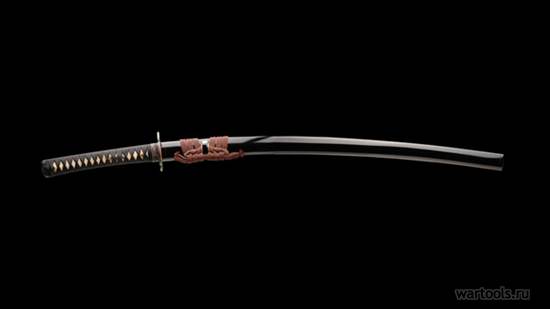
Phenomenal sharpness as the exceptional property of the Japanese sword is often found in popular publications about Katan. This property is most often due to the extremely high solidity of the cutting edge of the Katana (according to H. Tanimura 60-65 HRC Japanese katana against 50-58 HRC European swords). Here the error appears due to the confusion of sharpness and stability of sharpening. Katana can compally for a long time to sharpen, but is not "self-folding" - this myth originated mainly due to the erroneous attitudes of the Katan properties of the Tiglevo Bulat with carbide microzbinnos and recently discovered microstructures. As a result, the ability of the sword "cut steel as oil" or "to disseminate silk rolls" is historically unproved in the air. So often quoted "simultaneous hardness and elasticity" are not a combination of mutually exclusive properties, but a compromise within the laws of physics.

Fencing and scope of application
Quite often the art of ownership of the Japanese Kanaya Candyzutu (one of the most ancient schools of which Tencin Sydan Katori Synto-ryu) are not distinguished, and sometimes mixed with modern sports like Cando or Aikido, thereby mistakenly calling, for example, Kando as "ancient combat art". This occurs mainly from samurai films, Hollywood shields and (which is typically for children and adolescents) of such anime series as "Bleach" or "Kencin". Due to this, very popular popular myths about European weapons, emanating from the XVIII and XIX centuries, is very common that the Japanese Katana exceeds all other types of speed and accuracy due to their allegedly low weight and low blade thickness. This statement in itself is incorrect, if we take into account that the average katana is as well as the European combat sword (X-XIV types according to the classification of Evarte Okshott), weighed 1100-1200 grams. There are preserved copies of the sabers (0.9-1.1 kg), rapiers (up to 1.4 kg), checkers and Roman-German guests (0.6-1.2 kg), they weigh less than eight hundred grams. Thus, Katana is more likely to average than low weight. The thickness of the Japanese blade fluctuates on average from 6 to 9 mm and, as a rule, almost does not decrease towards the edge, which is characteristic of the saber blade. European swords have at the Garda on average 4-8 mm, which smoothly decrease to 2 mm at the island. Thus, European swords are actually more subtle than Japanese, which is also historically displayed in the form of unusual chopping advantages. From the point of view of physics, sharpness and stability of the blade depend on its geometry, which, in principle, depends on the thickness of the blade only indirectly. Two-handed grabs of a weakly sparkled blade between 70 and 80 cm also has its analogues in other parts of the light (for example, the German Gross Messer). Thus, the evidence that Katana is to some extent, there is no more quick or perfect, there is no logical point of view. Arguments like the historical absence of full-fledged martial arts and high-quality swords from other peoples outside the Japanese-Chinese culture are not taken into account, since the scientific point of view does not correspond to archaeological and historical facts.
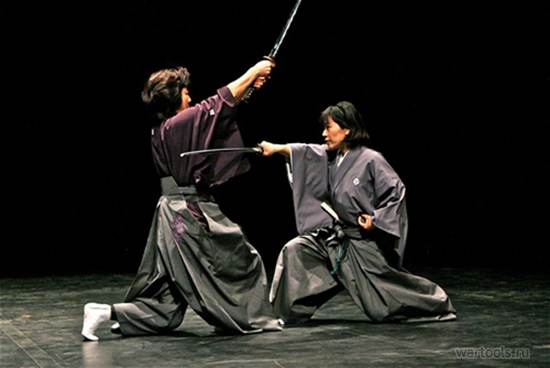
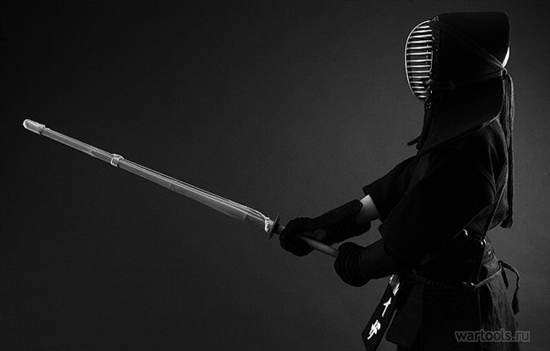
There are popular misconceptions, which also go in the opposite direction: often voiced by the opinion that Katana is exclusively cutting weapons for the duel of the robbery soldiers. This is due to the fact that today the overwhelming majority of authentic blades produced by Honored Masters of Japan are intended for collections or sports like "Tetsychiri" or "Jewy". Japanese swords produced before the Edo period ("one" - "old swords"), but are very diverse with respect to the geometry of the blade, curvature, center of gravity, weight, etc. while preserving the concept of nighborhood during the centuries. These swords were perfectly adapted to defeat traditional Japanese armor and had for this, as a rule, the required elasticity of the blade and the geometry of the cutting edge. Katana, which it is shown in the media (a rather soft core and very sharply solid cutting edge), appeared only during the Edo period. Thus, Japanese swords are historically multifunctional and were not limited to dispense of compete opponents. In the media, almost always the fact that the fencing Katana, which we know it today arose only in the XVII century from the Utigatan, which in the XV century happened from Tati. Combat swords Before the Sengokok and Edo period were not a fencing ridge as such and were not used accordingly - it is necessary to distinguish these two types of swords.

The specific scope of use of katana in most cases or is not exactly voiced, or distorted. So theses are born, which says that Katana is not only perfectly adapted to defeat all the varieties of armor, but also applies to any combat situation. In such assumptions, however, the effect of modern films about ninja and samurai, which, as a rule, has nothing to do with historical martial arts, weapons and tactics, is clearly visible. Prior to the Edo Samurai period was mainly horse archers who used the sword only in extreme cases if the spear of Yari or Naginat was out of reach or lost. Only by the decree of Sögun Tokugawa Ieais Katana became the "soul of samurai" and his personal fencing and status weapons, similar to the rapier and a sword in Europe, in the process of which the former civil wars and battles in full armor on horse are forever went into the past. Thus, the classical katana samurai starting from the XVII century was originally a duel arms designed for compete opponents, and, as a rule, did not come into contact in duels with traditional Japanese armor - the suitability of rolled for a dive or puncturing of armor or its absolute versatility. Thereby do not have historical foundations. . Tati's cavalry swords (often inherited) remained samurai parade weapons, but they were worn differently and actually rods were not. The European, Middle Eastern and Central Asian bladed weapons were adapted to defeat scaly, colts and lamellar armor, and the extreme load should have to withstand for this. Japanese armor did not contain so much metal, as they were Rather Archer, rather than a speaker, so the Japanese sword did not need to withstand similar tests.

